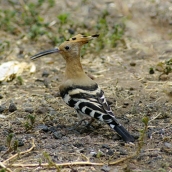Hoopoe, Tabobo (Upupa epops)
The hoopoe measures 26-28 cm in total length, with a wingspan of 44-48 cm. This unmistakeable species has a distinctive beige crown with black dots that can rise into a crest, broad black and white striped wings and a long curved beak. The tail is black with a white band. In Macaronesia it only breeds in the archipelagos of Madeira (Porto Santo) and the Canaries (throughout the islands, as well as the islets of La Graciosa and Lobos) but has occasionally been sighted in several islands of the Azores and Cape Verde, the Savage Islands and on the main island of Madeira. It mostly inhabits open xeric zones and low-lying farmland, but in the Canaries it also occupies lands at mid-altitude. Sometimes it is seen on the trails and glades of evergreen and pine forests, and there are records of appearances in high montane scrub, at around 2,000 m, though breeding has not been confirmed at this altitude. It mainly feeds on insects, larvae and invertebrates, including small reptiles (lizards and skinks). The breeding season begins as early as December or January and extends until June or even July. Clutches of 4-8 eggs are laid in the holes of stone walls, rocky peaks, derelict buildings, between rocks on the ground, in tree trunk hollows, metal drums and cement hatches at ground level. The hoopoe is a partially migratory species and birds generally arrive in early spring. Large flocks can congregate in specific locations (e.g., the sand dunes of the eastern Canary Islands and golf courses). The hoopoe is still common in Fuerteventura, Lanzarote and La Graciosa, as well as Porto Santo, but numbers have declined over the past few decades. That this bird no longer breeds in large areas of the Canaries, north Tenerife being a case in point, is a reflection of this fact. Threats to the hoopoe include chemical products used in farming, changes to agricultural systems, predation by introduced mammals and habitat alteration and loss.













